Hanfu renaissance
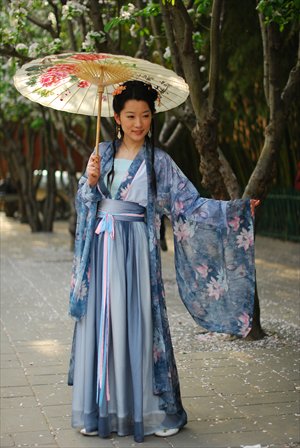
Many countries around the world boast distinctive national costumes. Japan has the kimono, Scotland has the kilt, Germany has the lederhosen and the US has jeans. But what about China? While home to more than 50 ethnic minorities that each have distinct folk costumes, the country's majority Han ethnic group has struggled to promote a universally-recognized costume in the modern era.
Han men and women commonly wear designer business suits or dresses to formal ceremonies, with daily casual attire among young people hardly differing from their peers in the West. Even the tangzhuang and qipao, a Chinese jacket for men and a figure-hugging dress for women respectively, which are commonly associated with Han people have Manchurian roots.
In March during the two sessions in Beijing, Chinese People's Political Consultative Conference member Zhang Gaiqin proposed promoting an official Han costume. "It's easy to recognize the traditional costumes of people from other countries, but there is no clear traditional costume for the Han ethnic group," she was quoted as saying by news portal Guangming Online.
Nearly a decade after the so-called hanfu movement began in a bid to reintroduce traditional Han clothing into modern life, opinions remain divided about whether it's worth reviving costumes that have questionable relevance and convenience.
Rejuvenating hanfu
Two young women at the forefront of the "hanfu movement" in Beijing are Huangfu Yuehua, 21, and Yang Na, 26, although you might not immediately know it to look at them.
They hardly stand out among diners at a downtown McDonald's restaurant in their modern garb, with the only hint of their traditionalist leanings being their unique hairstyles: buns adorned with antique hairpins.
"Our goal is simple: to let everybody know that Han people have their own clothing," said Huangfu.
Both Huangfu and Yang are members of the Beijing Hanfu Association (BHA), which since its founding in April 2009 has grown to include more than 300 members. Their objective is to "rejuvenate traditional clothing and carry forward the national culture," said Huangfu.
The group holds costume-themed activities that coincide with traditional festivals such as the Qingming (Tomb Sweeping) and Duanwu (Dragon Boat) festivals, which see them dress up and engage in festivities in public.
On April 4 during this year's Qingming Festival, about 80 BHA members clad in hanfu gathered at Liuyin Park in Dongcheng district to perform blessing ceremonies, pose for photos, play sports and enjoy a picnic under willow trees.
The association is not just focused on reviving traditional costume, with smaller groups also involved in promoting Han folk music, dances, literature, martial arts and archery.
They also regularly bring their hanfu out of the closet in daily life, with Huangfu recounting she once wore ancient-style red robes to a party for her great-grandfather's birthday. "Elderly people like traditional things, and he was very happy with my outfit," she recalled.
Yang, who works in the media, often wore hanfu when she was studying at the University of Southampton in England in 2006.
"The foreigners thought I looked prettier in hanfu than in Western dresses," said Yang, adding she helped establish the London-based British Hanfu Organization while she was abroad.
But just how practical is wearing traditional garments, such as long, flowing court dresses, in a bustling metropolis?
"You wouldn't wear a full-length dress if riding a bicycle," Huangfu solemnly pointed out. "There are more suitable short-sleeved tops and trousers to choose from. In the Song Dynasty (960-1279), for example, women often wore trousers instead of skirts."
Yang said that while it took some getting used to, she has no trouble wearing traditional garments. "One of the most troublesome things for me is that I have to carry bigger bags because I have to take so many clothes with me," she said.
The "hanfu movement" has predominantly been driven by females aged in their 20s and 30s, although the BHA has seen growing numbers of young men join as the organization widens its scope to include promotion of more crafts central to Han identity.
Han in glove
Most hanfu traditionalists are used to the surprised looks and misunderstandings they encounter when dressed in traditional garb in public. One of their biggest annoyances is people mistaking their clothes for Japanese or Korean traditional costumes.
There are distinct elements that distinguish hanfu from other Asian countries' clothing, insisted Huangfu.
"The kimono is similar to Tang Dynasty (618-907) hanfu because they (the Japanese) learned from our dress culture. On the other hand, Korean [hanbok] clothing imitates styles from the Ming Dynasty (1368-1644). If you look closely, you can see they are totally different," said Huangfu.
Aside from his contribution as a revered revolutionary leader, Sun Yat-sen was also involved in designing the iconic zhongshan zhuang (Chinese tunic suit). Although still a popular choice among Chinese leaders at formal occasions such as military parades, hanfu enthusiasts don't count it among their fashion collection because of its Western influence.
They also draw a clear line between hanfu and the qipao, or cheongsam, which originated among Manchus, the ruling class of Qing Dynasty (1644-1912) that suppressed Han clothing and customs. Yang added the qipao defies hanfu characteristics of "wide robes and broad sleeves."
Another surprise exclusion from hanfu is the tangzhuang, which captured the spotlight when former Chinese president Jiang Zemin and leaders of Asia-Pacific Economic Cooperation (APEC) economies wore the suit at the bloc's 2001 summit in Shanghai.
"The new tangzhuang is based on the Qing Dynasty men's jacket," explained Yang. "Its history is too short to represent Han culture's thousands of years."
Beijing is at the center of the hanfu renaissance, being home to stores that exclusively sell clothing more commonly seen in period TV dramas and kung fu blockbusters. Prices for hanfu outfits, such as the range at e-store Rumeng Nishang, range between 200 and 400 yuan ($32.50-$66).
Reclaiming identity
Rather than a fleeting fashion trend, some experts attribute the revival of hanfu to an effort among Han people to reconnect with their cultural roots and consolidate their identity.
"It's not just a problem of fashion. It (the 'hanfu movement') is rooted in anxiety over self-image that has long bothered Han people," said Zhou Xing, an anthropologist at Aichi University in Nagoya, Japan, who with other academics identified and labeled the movement in 2003.
Although the movement's influence and span has grown in recent years, it has also reached a turning point that has redefined it as a novelty, said Zhou. "To attract enough attention, it has become a kind of talent show. People dressed in hanfu offer sacrifices to ancestors, perform tea ceremonies and play traditional instruments," Zhou explained.
Yang concedes the "hanfu movement" has gradually lost momentum. Until 2006, she claims showing up in public clad in hanfu was enough to attract attention, adding that now many gimmicks have been adopted to promote the movement's cause.
"There is no difference between this and stage performances," said Yang.
Zhou described Zhang's proposal to promote a traditional Han costume as "unrealistic," saying such a move "shouldn't be enforced by the state."
"A government move in this direction could easily be interpreted as discriminating against ethnic minorities," agreed Huangfu.
But will China's 1.2 billion-strong Han population embrace their ancestors' garb anytime soon?
Zhou believes hanfu could make a comeback as formal attire for ceremonial, social or festive occasions, but notes those hoping to see it in daily life will be disappointed.
Huangfu and Yang echoed a somewhat nationalistic tone through their interviews with Metropolitan by frequently stressing the need for "our own" clothing.
"It's possible widespread Westernization of [Han] people's lifestyles has caused resistance against the 'hanfu movement,'" said Zhou.
Fashion timeline
With a colorful history dating back 3,000 years, Han-style dress suffered a centuries-long hiatus before its modern-day revival. Here's a brief snapshot at some of the styles and designs from influential dynasties that helped define hanfu.
Qin Dynasty (221BC-206BC)
Style: Classic black, unisex clothing.
A dynasty defined by broad-sleeved, loose-fitting gowns, black was the revered color. Clothing differed little between men and women, with the main divergence being in the waist: men wore leather belts and women donned silk ribbons. On the military front, officers among the Terracotta Warriors offer insight into the dress of elite with their long jackets and crested headdresses.
Han Dynasty (206BC-220AD)
Style: Robes, silk becomes sassy, rise of red.
One-piece garments with sloping necklines and square sleeves accessorized by silk girdles were the court attire for women. The embroidery and textile industries flourished during this period, particularly regarding silks and satins. During the Eastern Han Dynasty, red became popular for its symbolism as a "fire virtue." The shenyi (pictured below) was introduced and there was minimal class divide in costume, with farmers, workers and scholars adopting similar styles.
Photo: Courtesy of BHA
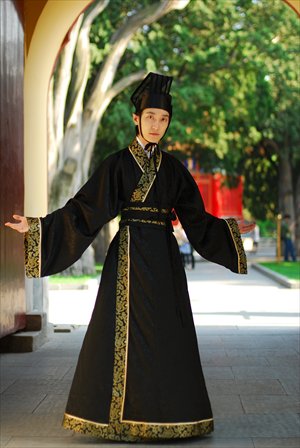
Tang Dynasty (618-907)
Style: Sexy outfits, cross-dressing craze.
Not only considered a golden age for arts and sciences, the Tang Dynasty sparked a fashion revolution. Cleavage was in for women and their previous concealing outfits were out. Many women wore transparent, short-sleeved shirts, high-waist brocade skirts and ribbons binding their breasts. It was also in vogue for women to dress in male clothing.
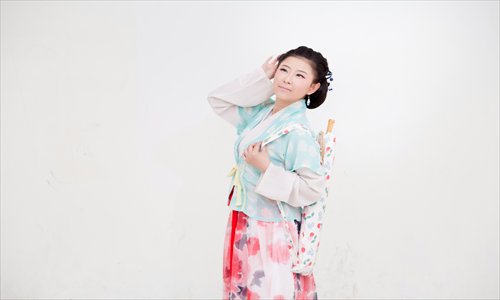
Song Dynasty (960-1279)
Style: Conservative, jade, floral patterns.
Women's fashion generally followed Tang Dynasty styles, although ribbons were replaced by jade amulets hung from belts to prevent dresses from flying up during wind gusts. Light whites and blues coupled patterns of peony, camellia, plum blossom and lily. Women wore garland headdresses, while male court officials wore wide-brimmed hats.
Photo: Courtesy of BHA
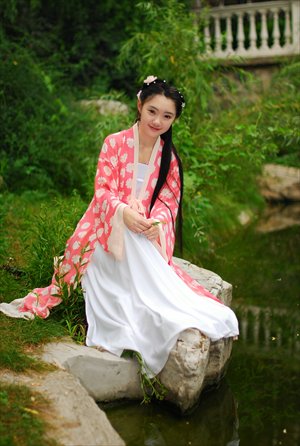
Ming Dynasty (1368-1644)
Style: Pleated dresses, circular collars.
Multi-layered, pleated dresses defined hanfu's final period before its suppression. Dubbed yuehua qun ("moonlight dresses"), white dresses were common among female aristocracy. The emergence of buttons signaled advancement in costume, while the popularization of Confucian philosophy ensured conservate overtones.
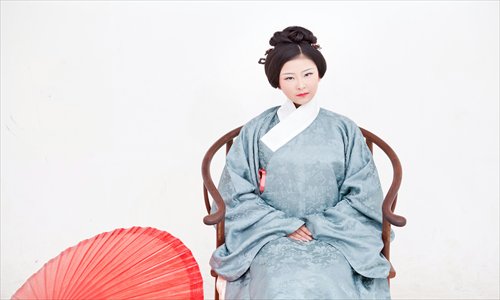
Sources: BHA, totallyhistory.com, chinaculture.org